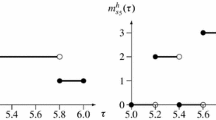Conclusion
It has been shown that for the Classical System a quasi-equilibrium cannot exist, unless we make the ad hoc assumption of inflexible nominal wages8. The equilibrium in the classical regime corresponds to the general competitive equilibrium, and of course the validity of Walras' Law cannot be questioned. At the same time, however, it has been shown that to extend these conclusions to the Keynesian system as well is not justified. The Keynesian system has, in general, a quasi-equilibrium. The model constructed in this paper and the resulting conclusions are significant because the model: (a) Incorporates the Keynesian notion of effective demand, which includes the demand for capital goods (investment) as being performed by a group of people distinct from the consumers (and so, answering Negishi's point, there is a prince in Hamlet!), (b) Unlike other models (like the recent paper by Glustoff), it does not rely on nominal wage rigidity to explain unemployment, but instead, again answering Negishi's remark, it explains rather than postulates why real wages do not adjust in the presence of unemployment so as to eliminate it. (c) It verifies the validity of Clower's proposition that in the Keynesian System Walras' Law holds only in equilibrium. (d) It reconsiles Bent Hansen's original quasi-equilibrium model with the Keynesian proposition of an unemployment “equilibrium”, against the apparent view of Hansen that to do that would require the assumption of a Phillips curve, a view also shared by Arrow and Hahn, and many others.
Similar content being viewed by others
References
K. Arrow and F. Hahn: General Competitive Analysis, San Francisco-Edinburgh 1971.
R. Barro and H. Grossman: A General Disequilibrium Model of Income and Employment, American Economic Review61 (1971), pp. 82–93.
R. Clower: The Keynesian Counterrevolution, in Hahn-Brechling (eds.): The Theory of Interest Rates, London 1965.
E. Glustoff: On the Existence of a Keynesian Equilibrium, Review of Economic Studies35 (1968), pp. 327–334.
B. Hansen: A Survey of General Equilibrium Systems, New York 1970.
J. M. Keynes: The General Theory of Employment, Interest, and Money, London 1936.
P. Korliras: A Disequilibrium Macroeconomic Model, Quarterly Journal of Economics89 (1975), pp. 56–80.
A. Leijonhufvud: On Keynesian Economics and the Economics of Keynes, Oxford 1968.
T. Negishi: Existence of an Under-Employment Equilibrium, in G. Schwödiauer (ed.): Equilibrium and Disequilibrium in Economic Theory, Dordrecht, forthcoming.
E. Phelps et al.: Microeconomic Foundations of Unemployment and Inflation Theory, New York 1970.
R. Solow and J. Stiglitz: Output, Employment and Wages in the Short-Run, Quarterly Journal of Economics82 (1968), pp. 537–560.
Author information
Authors and Affiliations
Additional information
An earlier version of this paper was presented in the December 1974 meeting of the Econometric Society in San Francisco. The author wishes to thank Prof. R. Clower, Prof. B. Hansen, Prof. S. Black, and Dr. G. Winckler for their valuable comments, but he obviously claims any errors for himself.
Rights and permissions
About this article
Cite this article
Korliras, P.G. On the theory of macroeconomic quasi-equilibria. Zeitschr. f. Nationalökonomie 36, 269–286 (1976). https://doi.org/10.1007/BF01287514
Received:
Issue Date:
DOI: https://doi.org/10.1007/BF01287514




